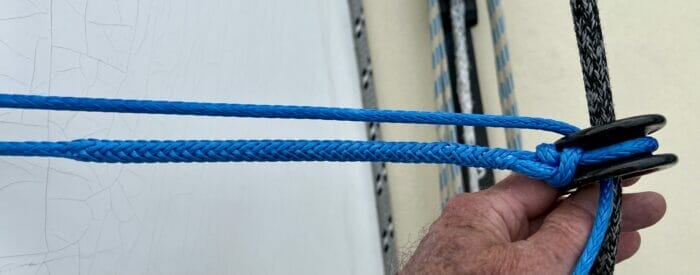
I was cleaning up the dog’s breakfast of frayed and knotted lines making up our jib in-haulers when I came up against the problem of how to attach the Amsteel™ line to the low-friction ring the sheet passes though.
A Brummel splice was one possibility, but it’s difficult to get a splice snugged up really hard so the ring won’t slip out; also, if I need to adjust the length, which I may, it’s pretty hard to undo and then redo a properly tapered splice.
Then it struck me, just use a buntline hitch, which pulls ever tighter under load, and then bury the end using my D-splicer.
Takes longer to write about it than it took to do.
And the beauty of this is that if I need to undo it to change the length, it’s simply a matter of pulling out the buried end, undoing the knot, adjusting, and putting it back together the same way.
You will note that I did not taper the buried end. That’s intentional, even though it reduces the strength a bit, since once the end is tapered, it would be hard to get it buried again.
One caution, I would not use this hack for anything heavily loaded like a halyard, since the knot will reduce the strength quite a bit—halyards, particularly using high-modulus lines, should always be spliced. But in this case I’m only using Amsteel for its low stretch, not strength—probably have a 50:1 safety margin.

Hi John,
I believe the buntline hitch to be an under-appreciated tool in one’s knot inventory. It is great for getting knots close to what it is going around as it is essentially a slip knot. One often mentioned drawback is that it is impossible to untie: it is very hard, but I have always succeeded (with a bit of time and tools), even in the heavily loaded reef lines where the line secures around the boom.
Another area of success is for bungie cord knots: pull the knot up tight and leave some tail and they have held where other knots in bungie cord eventually slip.
My best, Dick Stevenson, s/v Alchemy
Hi Dick,
I agree, works great on shock cord, although in that case I add a seizing around the end and standing part for added security and to neaten things up.
I like the notion and will using it.
From the pull to breaking tests I’ve seen online: non tapered always breaks at the bury:s end that “little bit” is surprising large. But short tapers pull out, perhaps short and sown compensates.
The testing was with eye splices, using anything else is, as you noted, weaker, perhaps the non taper would not be the first to go.
But all is moot, again as you noted, as getting lines comfortable to hold have unbelievable safety factors.
You’ve taught me more valuable lessons than any other.
Hi John
Curiously the link that you put in the article for the buntline hitch actually shows a variant, e-star, that works better for hollow braid dyneema. Interesting variant that side steps the taper and adjustment challenge?
Hi Simon,
I have used the e-star for other things, but have found that it does not pull as tight as the Buntline hitch and also one would still have the end flapping around. Of course one could do an e-star and my bury hack too. As to adjustment, it’s not really a challenge and just takes a moment.